
Art & Culture
various essays on, well, art and culture
Bookbinding & Conservation
lessons learned from this profession
Humor
ok, I'm not the guy from SNL,
but I still have a sense of humor
'Jim Downey' Stories
mostly true stories from my
adolescence
Personal Essays
more "it's all about me"
Politics
Iím at -7.13/-7.33 on The
Political Compass. Where
are you?
Society
observations on the human condition
Travel
Europe 1994
Kronach
Coburg
Vienna
Mödling
Vättis
Ramsgate
Chester
Wales 1998
Wales 2003
Wales 2006
CCGA Vignettes
|
Mödling
Getting out of Vienna was mercifully easy. American-style superhighway, but
at Autobahn speeds, for 20 minutes, and we were at the Hinterbrühl exit.
Onto a four lane road for a few minutes and we were in the small town of Mödling,
where Alix had been a summer student just a few years before I had been in Kronach.
The area has grown up a lot since she was there, the small town still intact as an
entity, but the surrounding area having essentially become a suburb of Vienna.
First thing we did was get stamps and see about information on the town, maybe find
a tourist information center where we could book a room, figuring the post office to
be the best bet. Little luck at the post office, so we decided to stop in at
one of the B&B's listed in our guidebooks . . . they were full up, made a few calls
around, and discovered that most other small hotels and B&B's were likewise full.
Almost apologetically, they recommended "The Beethoven", which our guidebook described
as a modern four-star hotel - in other words, expensive. Not outlandish, but
more than I would pay for any hotel room in the States.
What the hell. This was our vacation, after
all. It was a very nice hotel, just across the street from a small park where
the composer from whence they got their name used to relax. Seems he considered
Hinterbrühl to be the perfect place to recharge his batteries after the stresses
of composing for some Emperor or another. I was never clear on the details of
this, or whether he was actually supposed to have stayed at "The Beethoven", though
I suppose it must have been called something else at the time. And it probably
had been updated a bit too. In fact, the guidebook was right . . . it was very
modern. The building seemed to be only a few years old, with the latest in
contemporary artwork, framed sheets of music manuscripts (what else?), 'Euro-style'
leather chairs and lamps, and a bar that could have come straight out of an
"Embassy Suites" atrium. Nice room, though compact. We dropped off the
bags, jumped back in the car, and went exploring.
Driving around Mödling and Hinterbrühl,
Alix trying to get her bearings. I wanted a cup of espresso and some pastry
(this was Austria, after all), and we wound up in a little place just across the
street from the hostel that she stayed in when she was a student there. Turns
out the little place, which used to be a full-fledged snack bar, now is mostly a
small store, and the closest thing they had to pastry were these odd cookie-like
dry wafer bars (picture a Kit-Kat without the chocolate coating) that were made
somewhere on the other side of the continent. Oh well, at least they had
coffee and apfelsaft. The building where she stayed was this neat
apartment-style complex, built into and around this outcropping of stone at the
base of a small mountain. In fact, we were in a very narrow little valley
with mountains all around, so much so that the light seemed dim and the day late,
though it was still quite early in the afternoon. Alix told me that they
used to walk up the mountain there behind the building to the castle ruins at the
top. It sounded good to me, so finishing our drinks we got back in the car.
There was a road going up behind the building, and we figured that it had to get us
at least closer to the top.
Wrong. Or, actually, correct, but you
couldn't go up that way. Oh, we drove up there, along the narrow street
which led to a sort of lodge where the local political types met for their weekly
meetings, or some such. No public parking. Plenty of signs that made
a vague threatening sort of sense. I wasn't feeling that adventurous.
We backed down the road until there was room to turn the car around. The small
map of the area we got at the post office showed a parking place next to the nature
trail that went up the mountain, but to get there we had to jog over one ridge, and
go up a different way. Again, a steep climb with no where to turn around, but
fortunately we met no oncoming traffic. Sure enough, we came at last to a
parking area, which seemed to be both a public parking area for the hiking trail and
the parking lot for a couple of alpine lodges/restaurants, one of which was hosting
a wedding reception, the other seemed mostly empty.
Into the woods, and up the trail. Typical
nature trail, gravel where there might be mud, otherwise generally bark mulch or dirt
paths. Timbers set into the ground as steps for areas where the way was a
little steep and erosion needed to be controlled. As we wound around the
mountain, rising on the path, we came back to where we could overlook the alpine
lodges and parking area. There, starting at the lodges and going up the
mountain, was a broad expanse of rich green meadow, European red deer playing at
the far end. The pines were unlike any I had ever seen before, their
branches coming out in usual fashion except at the top, where they spread out
horizontally, twisting and turning back and forth, like multijointed alien fingers
splayed to hold a tray of fantastic size. The effect was one of layering,
each successive rank of trees on the hillside creating a terrace of their tops,
as though they had grown up flat against the underside of some ceiling.
Weird. I had never seen trees grow like that, nor did I again on our trip,
outside of that area.
Back and forth, up and up. By the time
we reached the summit, the sun was angling just over the tops of the other mountains
to the west, and I was tired and sweaty from the climb. Alix, breathing just
as hard as I was, said that she didn't remember the mountain being so high, but
that she and the others in her group didn't come up to the ruins more than once or
twice. And the ruins were great! It was the "Castle Mödling", a
small keep just large enough for a family and a few retainers, dating back to the
12th century. Not a lot left of it. The main building had most of the
walls of the ground floor, with parts of the upper floors left, built at the very
apex of the mountain, right on the living rock. Parts of a couple of outer
buildings, and the lines of the walls still visible in the way they shaped the
space of the mountaintop. The view from there was wonderful. Off to
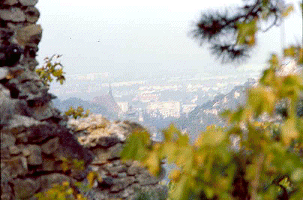 the north you could clearly see the sprawl of Vienna. Down the other side of
the mountain from where we started was the town of Mödling itself, still
largely undisturbed from it's medieval days. Across the main valley was
the ruins of another castle . . . the "Black Tower" (though it was actually the
natural dull white of limestone), built as a ruins by some crazed American during
the last century, who thought that he could make his fortune off of it (on a
continent where real ruins are about as common as dirt . . . go figure).
Slightly off in a different direction, on another mountain overlooking the same
valley, were the outlines of a classical temple . . . actually, a war memorial,
the first in Austria, though I have yet to find out to what war.
the north you could clearly see the sprawl of Vienna. Down the other side of
the mountain from where we started was the town of Mödling itself, still
largely undisturbed from it's medieval days. Across the main valley was
the ruins of another castle . . . the "Black Tower" (though it was actually the
natural dull white of limestone), built as a ruins by some crazed American during
the last century, who thought that he could make his fortune off of it (on a
continent where real ruins are about as common as dirt . . . go figure).
Slightly off in a different direction, on another mountain overlooking the same
valley, were the outlines of a classical temple . . . actually, a war memorial,
the first in Austria, though I have yet to find out to what war.
We took photos and played on the ruins a bit,
then started the trek down. Tired and thirsty, we stopped at the lodge that
looked mostly vacant for a drink. Inside a hedge off the trail, past some
huge chestnut tree that was so large and ancient that the limbs reaching out from
the trunk were big around as a man, supported by poles propped up under them,
buckeyes littering the ground thickly. We went up on one of the terraces,
sitting at a small wooden table, high enough that we could look over the hedge
off into the meadow we had seen from above. The deer were still playing at
the far end, though you needed binoculars to see them clearly. The owner
was sitting off to the side of the chestnut tree, talking with a friend, a bottle
of wine between them, playing with her dogs, who occasionally wandered over to say
hello and sniff us up a bit. I don't know if they weren't officially open,
or just that things were very casual in the off season, but no one bothered to
come over and wait on us. Eventually, Alix went inside, in quest of someone
to take our order and to find a restroom, and succeeded in both her quests.
The beer was good (I had a German import I knew I could trust) and the view
satisfying. Midafternoon turned into late afternoon, and eventually we
left to go into Mödling itself, to look around there before it grew dark.
Pulling into a tree-shrouded parking lot just
outside of the town proper, we left the Opel at the foot of one of the supporting
arches of an aqueduct, crossed a small footbridge over a creek onto the walking
path into town. It was cool and shady there, the late afternoon sun behind
the mountains. Most of the center of the village has been turned into a
pedestrian walkway since Alix was there, and the changes to the streets and shops
had her confused for a bit. Yup, the place sort of seemed like it had gone
yuppie, maybe part of a 'revitalization' effort to save the town while appealing
to the more monied young Viennese who hadn't killed themselves yet on the
roadways. Definitely upscale themes in a number of the stores, and little
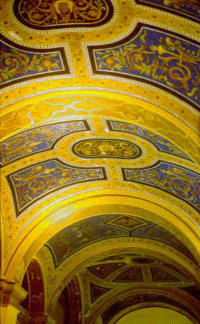 boutique shops featuring crafts and giftie items. Felt like one of the
pseudo-historical districts in some American downtown, except of course here all
the buildings really were 500 years old, all the streets had honest cobblestones
worn smooth by use instead of polishing machines, and the shops probably had been
originally owned by craftsmen, not just duded-up to look like it.
boutique shops featuring crafts and giftie items. Felt like one of the
pseudo-historical districts in some American downtown, except of course here all
the buildings really were 500 years old, all the streets had honest cobblestones
worn smooth by use instead of polishing machines, and the shops probably had been
originally owned by craftsmen, not just duded-up to look like it.
Actually, it was charming. And if it
took YUAs (Young Urban Austrians) shopping there to save the town, the trade-off
was probably worth it. We weren't there during the worst of the tourist or
Christmas season, so I will withhold final judgement. But walking around
at the beginning of autumn, with most of the shops closing at 5 as we wondered by,
it was delightful. Just as it started to get dark we made the yard of the
Catholic church on the edge of the town, slightly higher than the rest. It
was here that many people fleeing the oncoming Turks took refuge, as the Turks moved
on Vienna. But it did them little good, as the church was set fire with
incendiary shells from the Turkish artillery, and hundreds perished, trapped inside.
We stepped inside the church, quiet, unlit,
dark. There was enough light left outside that the stained glass windows,
neither as large nor elaborate as those we had seen in the great cathedrals but
somehow more real, glowed with a softness, a richness, a suppleness that one does
not normally associate with light. It felt like the light was moving slowly,
draping itself in colors, dancing in this odd fabric of glass, before settling over
us there in the aisle of the church. We only stayed a minute, respecting
the privacy of this small, living church, and the few people who were there praying
in it.
Besides, it was time for dinner. Down
again into the town, stopping at a tavern that had a menu posted, with people
sitting at tables outside in the cooling dark. Funny, it felt like we had
stepped back a couple of centuries, sitting there on the street in the small town,
a young family with some friends at the table next to us, their children and dogs
playing on the cobblestones between the tables, the waitress wearing a nondescript
tunic/dress, no cars, few lights and a sliver of waning moon. It got cold,
sitting there in our light jackets, but that made the steam rising from our meal
when it was brought out all the more enjoyable. Sad to say, I made the mistake
of trying one of the house brews, and discovered once again that the Viennese like
a sourness to their beer that I found distinctly distasteful. But dinner was
delicious otherwise, plentiful and filling. Honest food to fill the emptiness
that walking and hiking had left.
Finishing dinner, we strolled back to the car,
pausing at a coffeeshop which was just getting ready to close, to get dessert to
take back to the room with us. But it was still early, and much too soon to
retire for the night. We decided to go see if we could find "Castle
Liechtenstein".
The little map we had showed that there was some sort of 'historic site' above
Hinterbrühl that was marked as the 'Palace Liechtenstein'. As best
as we were able to determine, it was also at the site of some sort of retirement
community. We went that way, driving back and forth through a small warren
of suburban streets, working our way back up the ridge of mountains, until we came
to a small park-like entrance indicating that the retirement community was inside.
As we pulled in there, however, there was a large public parking area, with signs to
the castle. But the road continued on, and being basically lazy, I wanted to
get closer. Past a line of thick trees on the far edge of the parking lot, we
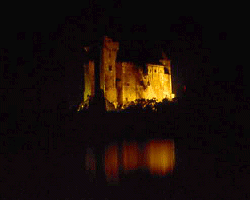 rounded a bend, and suddenly came upon an absolutely picture-postcard shot of the
castle, lit from below with powerful floodlamps. Furthermore, it was reflected
perfectly in the still surface of a small lake just off the road. It was a
good thing that there wasn't anyone right behind us, because I just stopped the car
there in the middle of the road just past the trees, stunned by the site.
rounded a bend, and suddenly came upon an absolutely picture-postcard shot of the
castle, lit from below with powerful floodlamps. Furthermore, it was reflected
perfectly in the still surface of a small lake just off the road. It was a
good thing that there wasn't anyone right behind us, because I just stopped the car
there in the middle of the road just past the trees, stunned by the site.
A fairy-tale castle, turrets and battlements,
banners flying. It sits, poised upon the tip of a rock outcropping, the
soaring walls of the lower stories adding to the effect of the structure being
higher than the clouds. You really feel like you are looking up into the sky,
upon the work of skilled magicians who know how to make buildings fly. Sure,
it was a trick of the lights, shining up from below, augmenting the overall
impression of floating. But it was also what the eyes wanted to see, what
the heart imagined since childhood when castles were mentioned in stories of kings
and grim tales of trolls.
Catching my breath, we drove down the road, trying
to get closer. Turns out that there is a retirement community there, a new
adaptation of the grand old palace of the same Liechtenstein family which had built
the castle a couple of hundred years before. We drove around their driveways
and parking lots until we found a place out of the way where we thought we could
leave the car for a few minutes. Crossing the open meadow between the palace
and the castle, the cold dew soaking into our shoes, we kept looking up at that
magical image, now towering over everything. On the other side of the meadow
we plunged into the trees at the base of the castle, and into darkness. We were
too close to the walls, and the light reflected back off the castle proper was shielded
from us. Groping in the darkness, trying to get our eyes to adjust, I cursed
myself for leaving my bag back at the room (because I had a good mini-mag flashlight
in it for such occasions). Then I remembered, I had the keys to the car, and
they had a small light built in the key. It wasn't much, but it was enough to
navigate by, until we got to the main path of the castle and up to the front gate.
It was closed, of course. But by the light
of the key we made out that it would open at 9 am. We followed the path back
to the meadow, deciding that the woods around the castle were rough enough that trying
to wander through them at night wasn't smart. We would come back in the
morning. We got back to the car, cold, feet wet, and tired. But still
we stopped back by the lake on the way out, and using a convenient boulder off the
side of the road, Alix took a long exposure picture of the castle and it's reflection
in the lake. You couldn't ask for a better photo.
We got back to 'The Beethoven' worn out but not
quite ready to crash. The room was equipped with a small stocked refrigerator,
and we stayed up, surfing the channels of the TV, drinking and eating our desserts,
writing postcards to family and friends.
Morning. We were feeling a little time pressure, figured that we'd get an
early breakfast, check out of the hotel, then go back to Castle Liechtenstein and
look around the outside thoroughly before the place opened up, and be there ready
to explore the inside when it did open. We needed to catch a fairly early
train in Vienna, and so would only have a couple of hours to see the inside of the
castle.
Of course, wanting to get an early start condemned
us. Breakfast was supposed to be served starting at 7:30. The sign out
front in the lobby said that, and we confirmed it with the desk clerk when we checked
in. We loaded the car at about 7:20, went into the lobby to wait for the
breakfast room to open. The lobby was dark, the bar not really cleaned up
properly, and the remains of a rather large party (which had been in full force when
we came in to go to bed) was still visible in the lounge area behind the bar.
Hmmm. I looked around behind the main desk for something that might signal a
porter or some other form of help. No luck. A nice, modern computer,
and a nice modern multifunction phone system, and I didn't have a clue about where
to even start to summon someone. We went back up to the room and tried to
call the front desk. That didn't help. There just wasn't anyone around
to be found anywhere.
Just about the time we were ready to give up on
breakfast, go off somewhere and get something else, the manager came in through the
front door. He looked around, really confused as to the state of things, and
then rushed to the phone system, punched some buttons, and began talking to someone
in furious and agitated Austrian. I couldn't follow a thing he said, but I was
rather glad that a) I wasn't the one on the receiving end of the call, and b) he
seemed to be doing something about getting us breakfast. Sure enough, as soon
as he put down the phone he apologized to us and the few other guests who had come
down to the lobby, opened the breakfast area, and asked us to please take seats . . .
they would get some food in to us right away.
Well, it wasn't right away, but they did get food
to us. Seems that he had called his wife, and between them they whipped up
coffee and brotchen, eggs, cold cuts, and the normal breakfast fare. His wife
came in with the coffee, apologizing profusely: the person responsible for
breakfast had evidently not come in on time, she wasn't sure why not, perhaps some
confusion over scheduling, and she was most sorry that we had to wait for so long.
I was too hungry, and too happy to get some coffee, to care much. The food, when
it arrived, was excellent and in generous supply, worthy of a four-star hotel.
And as I was sitting there, finishing the last of my breakfast, pure satisfaction
came over me, since I was able to watch the unsuspecting, but very guilty, morning
person come walking into the front of the building just about the same time the manager
came out of the kitchen with another basket of fresh brotchen.
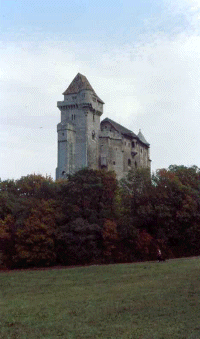 A few minutes later we were on the road to the
Castle. It was a clear, wonderful morning. Nothing brightens the day
quite like watching someone who so eminently deserves it getting chewed out.
Particularly when they had delayed my morning fix of coffee by almost an hour.
A few minutes later we were on the road to the
Castle. It was a clear, wonderful morning. Nothing brightens the day
quite like watching someone who so eminently deserves it getting chewed out.
Particularly when they had delayed my morning fix of coffee by almost an hour.
We got to the parking area, dropped off the car,
being careful to take the necessary cameras, binoculars, et cetera with us.
Down an easy path, greeting the fine older folks from the retirement community out
for a walk with their dogs, until once again we stood at the base of the castle walls
there in the woods. If anything, it was even more impressive in the light of
day. A small castle, nothing on the same scale as the castles we had visited
in Kronach or Coburg, but by the same measure much more human, much more like a home
where you could imagine yourself living, much more like the fairy-tale castles of
one's youthful imagination than the grand dreadnoughts of war we had seen before.
I've described other structures as being built onto
the living rock, and fairly so. But this place was amazing. It was at
the top of an outcropping of rock that itself must have presented a formidable
defensive structure. And it used this rock as part of the structure, part of
the design, part of the aesthetic of the place, in a way that seemed to be more like
sculpture than architecture. Don't get me wrong, I have a lot of respect for
what a good architect can do. Living with one will help cultivate such an
understanding. But this castle was more of a work of art. Around on
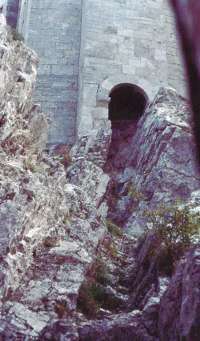 the far side from the main gate was a very jagged crevice in the foundation stone,
a dark band of rock between two higher areas of lighter stone, some two or three
feet wide, sloping away at about a 40 degree angle. The builders of the
castle chose this spot to put in a little decorated archway in the wall, smaller
than a man, where the main drainage of the castle exited. The effect was to
give the impression of a much larger, and more elaborate, gateway to some huge
castle, as seen from a distance. But of course that was an illusion; there
was no way an attacking force could enter there, since they would have to carve
through solid rock or substantial wall.
the far side from the main gate was a very jagged crevice in the foundation stone,
a dark band of rock between two higher areas of lighter stone, some two or three
feet wide, sloping away at about a 40 degree angle. The builders of the
castle chose this spot to put in a little decorated archway in the wall, smaller
than a man, where the main drainage of the castle exited. The effect was to
give the impression of a much larger, and more elaborate, gateway to some huge
castle, as seen from a distance. But of course that was an illusion; there
was no way an attacking force could enter there, since they would have to carve
through solid rock or substantial wall.
We went around the whole outside of the place,
admiring the towers of the castle proper rising high above the walls. These
weren't large towers, such as you would find in the huge defensive structures built
by Edward in Wales. Rather, they were parts of the fortified house, corners
and lookouts integrated into the living space. Think of the trademark castle
that Disney has in their theme parks, subtract the saccharine, and you get a better
dea of the overall effect. There was also a little balcony, with the supports
designed as a lord and lady looking out from the walls. In the place of
frightening gargoyles were happy or humorous human faces, watching you from on high.
I was glad we brought the binoculars.
We got to enjoy and explore all the outside of
the walls and finished up at the main gate just as the caretaker showed up to open
the place. He smiled at us, unlocked the doors, and told us to go on in and
play around, since he had some things to do before he would be ready to take our
admission money, and he would collect it from us on the way out.
First thing inside the gate it was clear that the
visual elements, the artistry which went into the construction of the castle that we
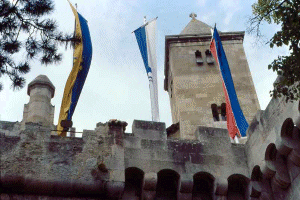 could see from outside the walls, was a theme continued throughout. Again, the
rock upon which the castle was built wasn't just a foundation, or a determining
force. Rather, it was sculpted into the walls, supported around and underneath
by quarried stone. A quick glance around the small courtyard there inside the
front gate, no bigger than the front yard in any suburban home, and up stairs to the
right and into the first floor of the building. The castle itself was long
and not very wide, with a main corridor running pretty much the length of the building,
stairways at either end. As the initial impression indicated, this was more a
fortified house than a great keep designed to withstand siege engines. The
walls were only a few feet thick, with occasional arrow loops down the length of the
corridor on the north side (the side facing away from the main courtyard), and
chambers on the south side overlooking the courtyard. The sensibility of this
was elegant: the rooms on the south would be warmed by the sun, and could
overlook the courtyard there, where gardens could grow at the base of the castle
proper, inside the walls. Further, to the north was the valley, and these
arrow loops therefore commanded a better field of fire. Inside the corridor,
as part of the design and decoration of the place, there were reliefs carved into
the supporting arches, and likewise carvings in the walls and over the doorways to
the chambers. We went all the way to the far end, and there came upon a
stairwell. This wasn't just a large, utilitarian circular staircase, as was
usual in most of the castles we visited. Rather, it was a five-sided winding
staircase with an open central shaft, with regular landings, giving a sense of
spaciousness and grace to the stairs. On all the supporting columns, and
along the walls were more relief carvings and full sculptures. In all these
cases the decorations were taken from your standard medieval bestiary; griffins,
dragons of several sorts, troll-like figures, and sea serpents, all jumbled up
with humorous and common images of people. Well, they may not actually
have been all jumbled up, but rather put into a system or sequence that wasn't
evident to us on a casual pass through. At about this time we also noticed
that the tiles in the floors had designs in them. Sometimes these were
hunting scenes, with stags, boar and dogs. Other times the designs were
purely geometric, like knotwork or some similar regular pattern. Here and
there, in areas where the elements and passage of many hands couldn't get to it
very easily, was evidence of paint and whitewash. This wasn't a military
post. This was a home.
could see from outside the walls, was a theme continued throughout. Again, the
rock upon which the castle was built wasn't just a foundation, or a determining
force. Rather, it was sculpted into the walls, supported around and underneath
by quarried stone. A quick glance around the small courtyard there inside the
front gate, no bigger than the front yard in any suburban home, and up stairs to the
right and into the first floor of the building. The castle itself was long
and not very wide, with a main corridor running pretty much the length of the building,
stairways at either end. As the initial impression indicated, this was more a
fortified house than a great keep designed to withstand siege engines. The
walls were only a few feet thick, with occasional arrow loops down the length of the
corridor on the north side (the side facing away from the main courtyard), and
chambers on the south side overlooking the courtyard. The sensibility of this
was elegant: the rooms on the south would be warmed by the sun, and could
overlook the courtyard there, where gardens could grow at the base of the castle
proper, inside the walls. Further, to the north was the valley, and these
arrow loops therefore commanded a better field of fire. Inside the corridor,
as part of the design and decoration of the place, there were reliefs carved into
the supporting arches, and likewise carvings in the walls and over the doorways to
the chambers. We went all the way to the far end, and there came upon a
stairwell. This wasn't just a large, utilitarian circular staircase, as was
usual in most of the castles we visited. Rather, it was a five-sided winding
staircase with an open central shaft, with regular landings, giving a sense of
spaciousness and grace to the stairs. On all the supporting columns, and
along the walls were more relief carvings and full sculptures. In all these
cases the decorations were taken from your standard medieval bestiary; griffins,
dragons of several sorts, troll-like figures, and sea serpents, all jumbled up
with humorous and common images of people. Well, they may not actually
have been all jumbled up, but rather put into a system or sequence that wasn't
evident to us on a casual pass through. At about this time we also noticed
that the tiles in the floors had designs in them. Sometimes these were
hunting scenes, with stags, boar and dogs. Other times the designs were
purely geometric, like knotwork or some similar regular pattern. Here and
there, in areas where the elements and passage of many hands couldn't get to it
very easily, was evidence of paint and whitewash. This wasn't a military
post. This was a home.
Most of the rooms had the tiles I mentioned.
Some rooms, either having been partially repaired, or rather partially damaged by
time, only had the raw wooden floor sitting on top of the supporting beams, without
the tiles. On the second floor of the castle were the main living quarters,
and we explored these first. The rooms were all labelled 'Knight's Room,'
'Lord's Room,' 'Priest's Quarters,' and so on. In several of the rooms were
items of furniture, at least some of it original, such as the wonderful stone table
with the base made out of intertwined medieval dolphins, and the top fashioned to
be a game table. Another room held plank tables, a great chest with wrought
iron strap hinges, and a very large, and very comfortable figure 'X' chair.
I think that the frame of the chair was original, though the fabric seat, armrests,
and back were of more recent manufacture. Modern banners made in the
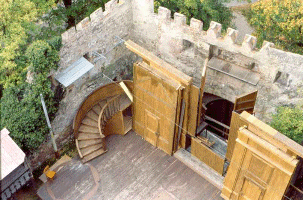 historical style were in many of the rooms, as were some tapestries and a few
paintings. From the large room (I would be overjoyed to have it as my
master bedroom) of the lord of the castle projected that small balcony we had
seen from outside the walls. Stepping out onto it in the morning sun, we
could survey the whole courtyard . . . and were delighted to be looking straight
down into the stage of a small summer-stock type theatre. Seems that the
castle is used for plays put on by the local theatre group, the walls of the
courtyard defining the limits of the stage. What a backdrop!
historical style were in many of the rooms, as were some tapestries and a few
paintings. From the large room (I would be overjoyed to have it as my
master bedroom) of the lord of the castle projected that small balcony we had
seen from outside the walls. Stepping out onto it in the morning sun, we
could survey the whole courtyard . . . and were delighted to be looking straight
down into the stage of a small summer-stock type theatre. Seems that the
castle is used for plays put on by the local theatre group, the walls of the
courtyard defining the limits of the stage. What a backdrop!
We went up to the upper floor of the castle,
which consisted mostly of a large room on top of the main keep at the western end
of the structure. This was the dormitory for the military personnel,
simple, stark now, with little of the decorations found throughout the rest of the
castle. From there, there was a narrow circular staircase up into a lookout
turret, with a small walk wound on the outside, facing south, west, and north, and
from this considerable height it was easy to look down into the valley and even
off past the mountains to Vienna. We spent some time there, enjoying the view
and the crisp wind coming up the mountain, and then went all the way down to the
lowest level of the castle.
This was where the kitchen, storage areas and
workshops were located. In the kitchen (not marked) were fireplaces in the
outside corners, and a large stone sink, big enough to wash a pig in. There
was a channel in the stone coming into the sink, which presumably at one time held
lead piping leading to a cistern. Heat and running water . . . all the
comforts of home if you don't mind a little lead in your diet.
Back up to the first floor, which contained
additional living quarters, a small hall, and the two-story high chapel.
Opening onto the chapel at the level of the second floor was a small balcony,
where the family of the lord of the castle could come to view mass. Other
than that, since this was a ground-level room, the only light came in from a couple
of small windows well up the wall. And, interestingly, the door to the
chapel was heavy timbers faced with iron, and could be barred from the inside,
thereby making it more secure if attackers gained access to the main corridor.
It was all a delight on a human scale. But
we were pressed for time, and couldn't linger there. We thanked the caretaker,
paid our admission fee and bought a little booklet about the castle (they didn't
have an English version . . . but the floorplans are excellent and my German is
still good enough that I can crib notes from it), and left, looking back now and
again as we walked to the car. Pausing one more time to enjoy the view of
the castle, we pulled out of the parking lot and headed back to Vienna.
It was a fairly straightforward matter to get back into town, fill the tank of
the rental car, and go to the train station. We made arrangements for
Hertz to pick the car up in the parking garage of the station, got the bags
inside and to our platform, took care of the details of exchanging some money
into Swiss Francs, getting travel snacks from one of the shops, contacting our
friends in Switzerland to let them know the final information about our arrival,
et cetera. Walking through the huge, noisy train station on the way from
seeing to these details, I felt strongly that I would not much miss Vienna, but
would look forward to the day when I returned to Mödling, Hinterbrühl,
and Castle Liechtenstein.
|
|

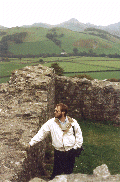




 the north you could clearly see the sprawl of Vienna. Down the other side of
the mountain from where we started was the town of Mödling itself, still
largely undisturbed from it's medieval days. Across the main valley was
the ruins of another castle . . . the "Black Tower" (though it was actually the
natural dull white of limestone), built as a ruins by some crazed American during
the last century, who thought that he could make his fortune off of it (on a
continent where real ruins are about as common as dirt . . . go figure).
Slightly off in a different direction, on another mountain overlooking the same
valley, were the outlines of a classical temple . . . actually, a war memorial,
the first in Austria, though I have yet to find out to what war.
the north you could clearly see the sprawl of Vienna. Down the other side of
the mountain from where we started was the town of Mödling itself, still
largely undisturbed from it's medieval days. Across the main valley was
the ruins of another castle . . . the "Black Tower" (though it was actually the
natural dull white of limestone), built as a ruins by some crazed American during
the last century, who thought that he could make his fortune off of it (on a
continent where real ruins are about as common as dirt . . . go figure).
Slightly off in a different direction, on another mountain overlooking the same
valley, were the outlines of a classical temple . . . actually, a war memorial,
the first in Austria, though I have yet to find out to what war. boutique shops featuring crafts and giftie items. Felt like one of the
pseudo-historical districts in some American downtown, except of course here all
the buildings really were 500 years old, all the streets had honest cobblestones
worn smooth by use instead of polishing machines, and the shops probably had been
originally owned by craftsmen, not just duded-up to look like it.
boutique shops featuring crafts and giftie items. Felt like one of the
pseudo-historical districts in some American downtown, except of course here all
the buildings really were 500 years old, all the streets had honest cobblestones
worn smooth by use instead of polishing machines, and the shops probably had been
originally owned by craftsmen, not just duded-up to look like it.